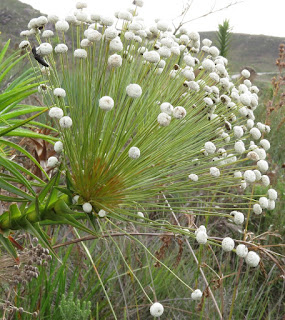Three of the participants from my SE Brazil tour continued with me to Belo Horizonte to join Fabrice Schmitt’s tour of the state of Minas Gerais. This was my first time to this state, and even though I’ve birded the Cerrado biome of Brazil in several disparate areas, there are some birds with very restricted distributions that occur only in this area.
One of my
favorite sightings from here was Hyacinth Visorbearer, which we saw while looking
for (but not seeing) the much less showy but rarer Cipo Canastero.
Cinereous
Warbling-Finch was a lucky find and the only lifer for Fabrice on the tour (and
of course for me).
I could
botanize here for weeks. This Cambessedesia
hilariana may be the most unusual melastome I’ve ever seen.
This monocot
is a Vellozia, a South American
counterpart to the South African Xerophyta,
and the majority of species are found just in the state of Minas Gerais.
Another
monocot is this Paepalanthus, in the
family Eriocaulaceae. Other than the flowers, it looks a lot like a grass, and
genetics show it is actually in the same order.
After Cipó,
we traveled to Caraça Sanctuary, an old monastery in a magical setting. The
habitat here is actually a transition from SE Atlantic Rainforest to Cerrado,
the former dominating.
Swallow-tailed
Manakin is a bird of the Atlantic Rainforests – the original “tanager,” as its
local name, probably derived from the Tupi-Guarani, is tangará. My guess is that the first collectors in Brazil bunched
these up with hundreds of specimens of other colorful birds (including what we
now call tanagers) from the region and sent them back to Europe for official
scientific description. The name suggested would have been attached to the first ones grabbed.
Maned Wolf
is the main reason that so many tourists come to Caraça. It was a very special
experience to be so close to one of these normally very wary and hard-to-see
mammals, but they have become accustomed to this feeding station only after
many years.
We birded
the trails at Caraça as much as we could, but a series of fronts brought a lot
of rain, making it difficult.
Butterflies
were hard to come by in this super wet period (supposedly one of the wettest Novembers
ever in Minas Gerais), but when the sun came out the ones we found were quite
special. This is the metalmark Panara
soana.
On our way
westward to the final tour destination several hours to the west, we stopped by
a lake in the city of Belo Horizonte where we found Southern Pochard, a long expected
lifer for me.
It continued
to rain here, usually not very heavy, but rather constant and difficult to bird
in. But it clearly had been raining harder, and the river where we usually find
Brazilian Merganser was a raging torrent for its entire length.
Yet we did
have some breaks in the weather and were able to see birds from the bus during
the drives. Red-legged Seriema is one of the most photogenic birds I know.
These two
nestling Burrowing Owls were right next to the road. I find it interesting how
they prefer to rest on their entire foot rather than just on the toes, the way
most birds perch.



























No comments:
Post a Comment